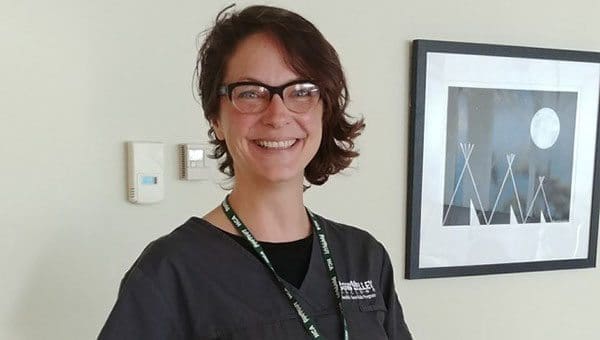Special Report
Name: Amy Mahon
Occupation: Mother of four children, full-time administrative assistant for Alberta Health Services
Age: 41
Amy Mahon remembers her breaking point. It was the day she opened a letter from the Canada Revenue Agency and read that she owed $5,000 in back taxes.
She remembers thinking, “Oh my god, on top of everything else?”
In 2012, Mahon, 41, was separated from her partner and found herself raising four children, who were ages two to 12. She had a full-time job, but over the following year as a single parent and not yet receiving child support from her ex-partner, the bills kept piling up – along with her stress.
“I was struggling with doing things on my own, raising four kids alone, and that set me into financial distress over time,” she says. “I was losing sleep and avoiding phone calls from unknown numbers.”
Through it all, she never missed work as an administrative assistant with Alberta Health Services. But the burden of her financial problems began to affect everyone in the family and every facet of her life.
“I was stressed out even about field trip forms from my kids’ school,” because they would require spending more money she didn’t have. “Each little detail of my life was impacted.”
She kept her money problems to herself, never telling the children about the dire finances.
“You feel embarrassed and awful for being that avoider … just not meeting your responsibilities. It affects your self-esteem and self-confidence,” Mahon says.
When the tax bill arrived in the mail, she knew she couldn’t carry on – she now owed more than $11,000. She had been borrowing from lending outlets to help meet her monthly payments.
“I used Money Mart to try to keep up but it ended up becoming too hard to make the payments.”
She began doing online research on how to pay off debt and found Bromwich + Smith’s website. She called for a free consultation with one of its licensed insolvency trustees and debt relief specialists.
“Just talking to someone over the phone, I felt better. To just not be ashamed of myself … it wasn’t that I was irresponsible … it was a series of circumstances that was unmanageable and I needed help.”
Over several sessions, she and her debt relief specialist decided that bankruptcy was her best option.
“I went in very hopeful and I walked out totally relieved,” she said. She recalls her debt relief specialist saying, “Once you sign this, it’s the end of this stage for you.”
“I literally skipped out of the appointment and was ready to make a new start.”
Mahon and her licensed insolvency trustee, Shawn Stack with Bromwich + Smith, looked at a number of options before deciding bankruptcy was the best solution.
| What is personal bankruptcy?
Personal bankruptcy in Canada is defined as surrendering everything you own to a licensed insolvency trustee in exchange for the elimination of your debts. Certain exceptions that vary by province allow you to keep some minimum necessities, according to the Bankruptcy Canada website. By the numbers:
Source: Bankruptcy Canada in 2015, Canadian Economic Development |
“Nobody wants to file for bankruptcy and Amy was no different,” said Stack.
“We considered the merits of a debt management plan (paying back all the debt in a three-to-four-year period), but it just wasn’t possible, the payments were too high,” Stack says.
Ultimately, bankruptcy was the best solution for Mahon and her children, he adds.
“The reality is that sometimes the hardest thing to do is the best thing for you and your family. Just as Amy discovered, the hardest part is actually allowing yourself the right and the dignity to reach out,” said Stack.
To Mahon’s relief, once the bankruptcy was filed, the phone calls from creditors abruptly ended.
Now she has a savings routine and is optimistic about the future. “Five years later, I can say I am debt free.”
She has been able to make investments two years in a row at tax time, buy a new couch with cash, has a healthy savings account and her credit rating is improving. And she’s content to continue renting her home.
Mahon is taking some college courses that will help her pursue her dream of starting a business.
For those who are in financial trouble, she says, “Definitely reach out and investigate your options, because bankruptcy isn’t the only way.”
Five years ago, she couldn’t imagine feeling this good about her life.
“(It’s) inspiring me to become more financially healthy. When I put away money, I’m excited about saving money, and the hard work I’ve put in from saving my life.”
In Part 3 of Back in Balance, read about Linda Pierce, who worked three part-time jobs to keep food on the table, until it all fell apart.
This feature was produced in partnership with Bromwich + Smith and Troy Media.
The views, opinions and positions expressed by columnists and contributors are the author’s alone. They do not inherently or expressly reflect the views, opinions and/or positions of our publication.



